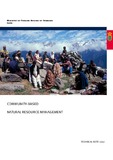| dc.description.abstract | This technical note gives a brief introduction to community-based natural resource management
(CBNRM) and how this concept may be used as a development strategy. CBNRM has the triple
objective of poverty reduction, natural resource conservation and good governance. The opportunity
and challenge is to pursue these objectives simultaneously, as they are not, by default, mutually
supportive. Lessons learnt from CBNRM will be useful when designing community-based climate
adaptation strategies. Thus, this note is a contribution to an ongoing debate as well as a product of
the long-standing experiences of Danida’s environmental portfolio.
The note has been produced in cooperation with the Department for Forest, Landscape and
Planning, Faculty of Life Sciences at the University of Copenhagen. Many practitioners have
contributed through a fruitful peer review process. Dr. Thorsten Treue together with Iben Nathan
have been the main contributors to the final note.
Involving local communities and securing the rights of poor and marginalised groups in sustainable
management of natural resources is a central theme in international development assistance. The
poverty-governance-environment link has been further highlighted in recent years through
interventions aimed at building capacity for resilience (disaster preparedness) as well as adapting to
climate change.
A successful implementation of CBNRM often requires changes at three different levels of society:
1) the national level, 2) the local level and the link between these, and 3) the intermediate level. At
the national level, policies and the legislative framework normally needs adjustment and revision to
establish an enabling environment that makes CBNRM attractive to local communities. At the
intermediate level, it is important to promote the model of decentralised natural resource
management that is most likely to work under the given political circumstances. In particular, this
involves a choice between: (i) devolution of natural resource management authority to elected local
governments, and (ii) deconcentration of line agencies, authorising district-level officers to delegate
management authority to local communities. At the local level, it is crucial that CBNRM establishes
significant economic incentives for managing and conserving the resource, which is closely related
to clearly defined and officially supported tenure systems, as well as to revenue-sharing
mechanisms. Furthermore, CBNRM should result in a coordination of resource use by numerous
individuals, thus establishing an ‘optimal’ rate of production and consumption at the local level as
well as for society at large.
In practical terms, it is the elaboration, implementation and experience-based revision of resource
management plans at local levels that determine the actual performance of CBNRM on the ground.
The poverty reduction rationale of CBNRM, as an alternative to open access resource use, is that
the total resource value can be maintained or enhanced, and that the costs and benefits of
management can be distributed equitably, so that all community members, within a reasonable time
horizon, experience a net gain, or at least a zero loss. Resource conservation requires harvest not to
exceed increment over the long term. This calls for reasonably accurate knowledge about the extent
and growth of the resource, as well as reliable recording of harvest volumes. Even so, CBNRM
could still fail at the local level if inefficient rule enforcement allows free-riders to over-harvest the
resource, and/or if inequitable distribution of costs and benefits leads to a breakdown of
management rules and subsequent over-harvesting or permanent marginalisation of certain groups.
Therefore, the establishment and maintenance of good governance or “appropriate decision-making
iii
arrangements” is the only feasible way to prevent the failure (or ensure the success) of CBNRM.
Decision-making arrangements specify who decides what in relation to whom. Good governance at
local level can be promoted through CBNRM legislation that establishes democratic conditions of
collective choice, so that all members of a community (including women and other potentially
vulnerable groups) get the opportunity to participate in defining: (i) the purpose of resource
management, and (ii) the resulting management plan, including how it is enforced, and how
products and benefits from the common resource are distributed. Furthermore, communities must
hold authority to control free-riding by punishing defaulters, and community leaders must be
downwards accountable to the people they represent.
It would be naïve to assume that, once initiated, CBNRM is a guaranteed self-sustaining success,
which needs no monitoring or adjustment. Regular monitoring of CBNRM processes should be
conducted to adjust associated policies, legislative framework and implementation strategies, so that
failures may be corrected and positive effects enhanced. Monitoring the progress of planned
CBNRM activities should be simple and embedded within existing official monitoring systems to
ensure sustainability. However, assessment of the degree to which CBNRM is achieving its triple
objective should probably be carried out by independent research centres, NGOs and university
departments that are not directly engaged in the implementation as such.
CBNRM is not a stand-alone solution to poverty, resource degradation and bad governance. Rather
it is a development process and constant power struggle. Thus, even after years of implementation,
donors are still likely to have a mission in promoting CBNRM. Lessons learnt will feed into the
new agenda of community-based adaptation to climate change. Donor support may be channelled as
programme-based or as earmarked support for monitoring and research that deliver credible and
easily accessible information. Checks and balances can be supported through civil society as well as
the media. An informed public debate based on the results of sound monitoring is, in all likelihood,
the key to the long-term success of CBNRM. | en |

